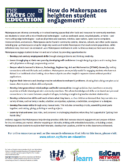How do Makerspaces heighten student engagement?
Makerspaces engage students to learn in and out of school...
Makerspaces are informal community or in-school learning spaces that offer tools and resources for community members and students to tinker with a mix of traditional technologies – such as cardboard, wood, recycled plastic, or fabric – and more cutting-edge technologies – such as 3D printers and scanners, robotics, laser cutters, open-source computers, microcontrollers, and sensors. Makerspaces can be found in community centres, libraries, schools, and other public spaces, including pop-up Makerspaces setup for single day events and mobile Makerspaces that reach remote populations. While definitions vary, there were an estimated 1,400 Makerspaces worldwide in 2016: 14 times as many as there were in 2006.
Makerspaces engage students to learn in and out of school, by providing opportunities to:
- Develop 21st century employment skills through solving problems and thinking creatively.
- Learn through play at their own pace by developing self-confidence through designing objects and creating them with 3D printers or through programming a robot.
- Deepen what is learned in Science, Technology, Engineering, Art and Mathematics (STEAM) classes, by making connections with real-life tasks and problems. Makerspaces are especially useful for engaging students who have not thrived in a traditional school setting, since these subjects are often taught in separate classes without practical applications.
- Explore their interests and develop creative solutions to real-world problems, showing that solving complex social issues often requires multiple skills and people.
- Develop intergenerational relationships and build communities through activities that draw from community expertise and build shared goals with community members. This allows knowledge and skills to be shared and personal connections to be created between people of all ages, including strengthening teacher-student relationships.
- Develop collaboration skills and teach others what they learn, so that children understand that they can take on a variety of roles, such as being a leader, a builder, an organizer, a planner, a technician, an engineer or a designer.
- Develop fine motor skills through using manual tools. This includes connecting circuits, assembling small parts together, and cutting, gluing, polishing or sanding objects.
- Learn by trial and error, take risks, and persevere in challenging situations where they feel supported in “getting their hands dirty.”
Evidence suggests that Makerspaces help develop practical skills that increase student engagement and prepare children for the 21st century job market. Whether repairing an old radio, knitting with embedded wearables, or building a robot, Makerspaces allow students to explore their interests, develop their passions, and thrive in the classroom and beyond.
Additional Information Resources
Davidson, A.-L. (2017). You too can experience the “maker scream. Concordia University. Retrieved from www.concordia.ca/cunews/main/stories/2017/05/03/maker-scream-education-professor-saltise-winner-ann-louise-davidson.html
Davidson, A.-L. (2017). On Focus. Retrieved from www.linkedin.com/pulse/focus-ann-louise-davidson/
Davidson, A.-L. (2017). This Easter, Conquer the Impossible with Your Kids. Retrieved from www.linkedin.com/pulse/easter-conquer-impossible-your-kids-ann-louise-davidson/
References
Andersson, P. (2015). Digital fabrication and open concepts: An emergent paradigm of consumer electronics production. (Bachelor thesis, Umeå University). Retrieved from www.diva-portal.org/smash/get/diva2:822484/FULLTEXT0
Davidson, A.-L., Price, D. (2018). Does Your School Have the Maker Fever? An Experiential Learning Approach to Developing Maker Competencies. Learning Landscapes, 11(1), 103-120. Retrieved from www.learninglandscapes.ca/index.php/learnland/article/view/926/918
Lou, N., & Peek, K. (2016). “By The Numbers: The Rise of the Makerspace.” Popular Science. Retrieved from www.popsci.com/rise-makerspace-by-numbers
Fleming, L. (2015). World of making: Best practices for establishing a makerspace for your school. Thousand Oaks, CA: Corwin.
Peppler, K., Halverson, E., & Kafai, Y. (Eds.). (2016). Makeology: Makerspaces as learning environments (Volume 1). New York, NY: Routledge.
Peppler, K., Halverson, E., & Kafai, Y. (Eds.). (2016). Makeology: Makers as learners (Volume 2). New York, NY: Routledge.
Sheridan, K., Halverson, E. R., Litts, B., Brahms, L., Jacobs-Priebe, L., & Owens, T. (2014). Learning in the making: A comparative case study of three makerspaces. Harvard Educational Review, 84, 505–531.

